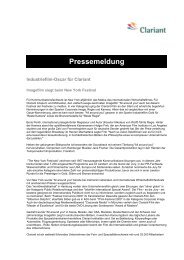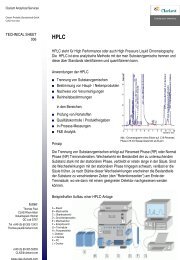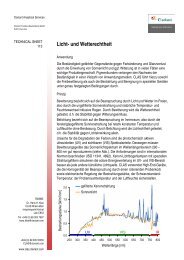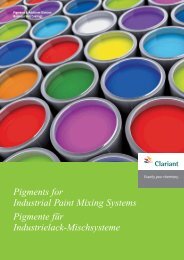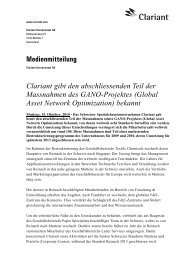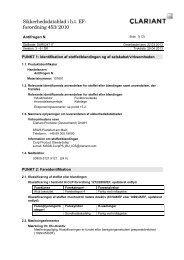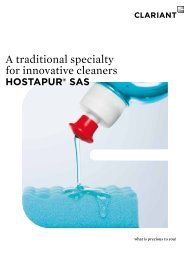CESA® Additive Masterbatches - Clariant
CESA® Additive Masterbatches - Clariant
CESA® Additive Masterbatches - Clariant
You also want an ePaper? Increase the reach of your titles
YUMPU automatically turns print PDFs into web optimized ePapers that Google loves.
Processing Aids, Mold Release,<br />
Cleaning Agents & Regrind Optimization<br />
Processing Aids<br />
During the extrusion process, CESAprocess<br />
masterbatches coat the inner<br />
surface of the die, reducing the friction<br />
between the melt and the metal and<br />
allowing polymers to extrude more<br />
easily. By lowering the friction and<br />
eliminating or reducing melt-fracture<br />
and die buildup, CESA-process enables<br />
difficult-to-process materials such as<br />
narrow-molecular-weight LLDPE and<br />
LLDPE-rich blends to run on existing<br />
extrusion lines.<br />
An example is CESA-process AEH603, a<br />
masterbatch based on fluoroelastomers.<br />
Developed for LLDPE and metallocene<br />
film extrusion, it can be used in conjunction<br />
with high quantities of fillers,<br />
antiblocking agents and inorganic<br />
pigments. In addition to eliminating<br />
melt-fracture and reducing die buildup,<br />
the use of this masterbatch enhances<br />
the optical properties of the film by<br />
improving its transparency.<br />
Mold Release<br />
The addition of CESA-release masterbatches<br />
to polymers during processing<br />
prevents parts from sticking to the mold<br />
cavity, facilitating their removal. Other<br />
advantages include reduced cycle times<br />
and increased machine output.<br />
Cleaning Agents<br />
Plastics processing periodically requires<br />
complete removal of thermo-oxidized<br />
deposits from extruders and injection<br />
molding machines. CESA-clean<br />
masterbatches permit fast, economical<br />
cleaning of machinery to facilitate color<br />
or resin changes with minimal downtime<br />
and loss of virgin material.<br />
One example is CESA-clean 9104<br />
masterbatch, a balanced mixture of<br />
surface-active substances and fillers<br />
with a low abrasive power, based on<br />
low-density polyethylene. Widely used<br />
for purging extruders and injection<br />
presses, the masterbatch allows quick<br />
changes of color and materials of<br />
varying viscosities.<br />
Regrind Optimization<br />
Re-using post-industrial or post-consumer<br />
polyester regrind has typically<br />
been limited due to the adverse effects<br />
of heat and moisture on the virgin resin.<br />
CESA-extend masterbatches utilize<br />
an oligomeric reactant to repair the<br />
damage and restore the resin’s Intrinsic<br />
Viscosity (IV). Processors can then use<br />
higher proportions of recycled resin<br />
while maintaining the same processing<br />
properties as virgin PET.<br />
A series of CESA-extend masterbatches<br />
with a variety of carrier resins is available<br />
for clear and opaque applications.<br />
These include extruded polyester sheet<br />
and strapping, stretch blow-molded<br />
PET bottles, foamed PET sheet or film<br />
and pelletizing undried recycle or scrap.<br />
15



